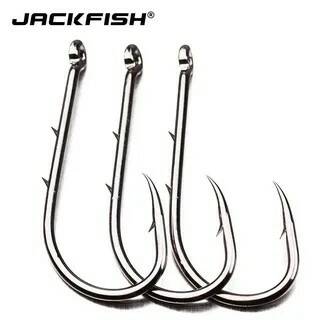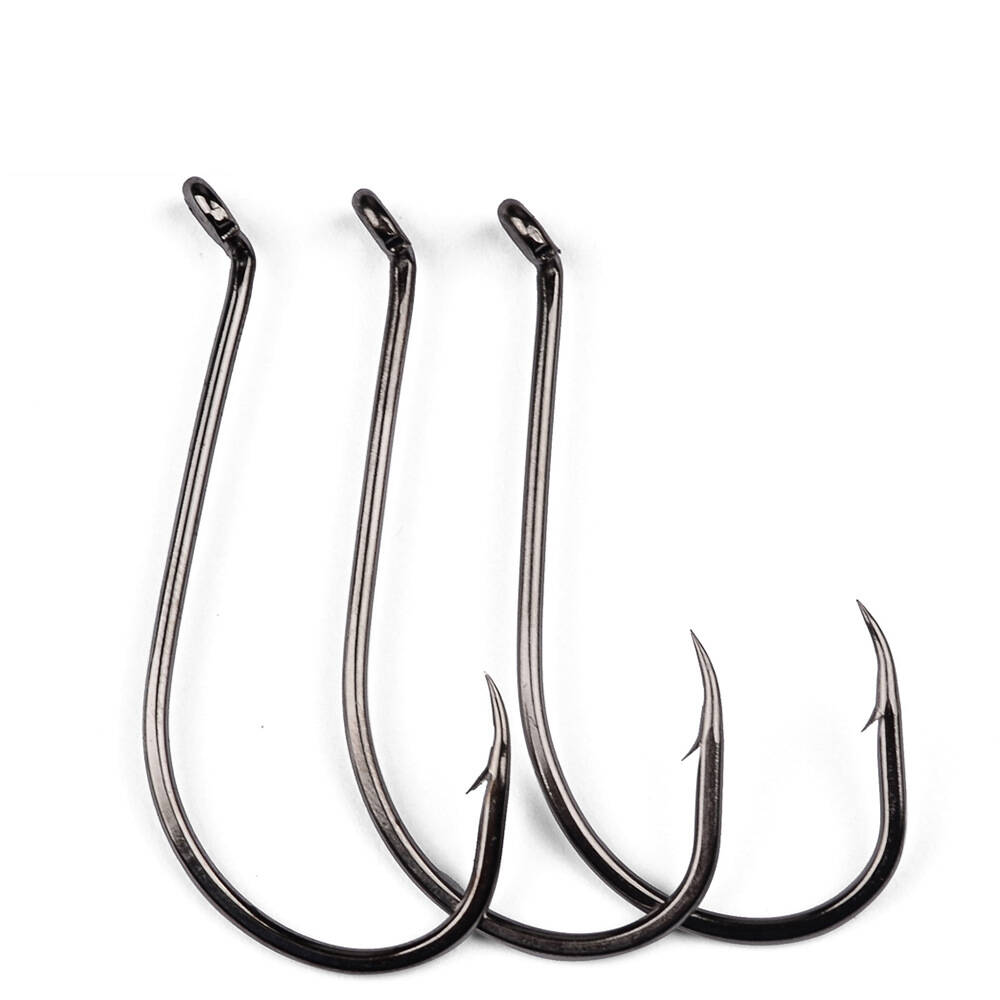
Fishing Hook
A fishing hook is a small, sharp metal device that is attached to the end of a fishing line. Its primary purpose is to impale and hold onto the mouth or jaw of a fish, allowing the angler to reel in the catch. Fishing hooks come in a wide variety of sizes, shapes, and materials, each suited to specific types of fish, bait, and fishing techniques. Some of the most common types of fishing hooks include J-hooks, circle hooks, treble hooks, and barbless hooks. The size of a hook is typically denoted by a number, with smaller numbers indicating larger hooks. Fishing hooks can be made from various materials such as steel, titanium, and carbon fiber. The use of barbless hooks is becoming increasingly popular in catch-and-release fishing, as they cause less damage to the fish and make it easier to release them back into the water unharmed.
Types of fishing hooks
There are various types of fishing hooks available, each designed for specific types of fish, bait, and fishing techniques. Here are some of the most common types of fishing hooks:
- J-hooks: J-hooks have a distinct “J” shape and are the most commonly used hook for a wide range of fishing applications.
- Circle hooks: Circle hooks have a rounded shape that allows the fish to swallow the bait before the hook sets in the corner of the fish’s mouth, reducing the risk of gut hooking.
- Treble hooks: Treble hooks are three-pronged hooks that are commonly used in lure fishing for species such as bass, pike, and musky.
- Octopus hooks: Octopus hooks have a short shank and a wide gap that make them ideal for live bait fishing.
- Baitholder hooks: Baitholder hooks have small barbs on the shank to hold the bait in place and are commonly used in bottom fishing.
- Fly hooks: Fly hooks are specialized hooks used in fly fishing, and come in a range of sizes and shapes.
- Worm hooks: Worm hooks are designed to hold soft plastic baits and are commonly used in bass fishing.
These are just a few examples of the many different types of fishing hooks available. The choice of hook will depend on the type of fishing you are doing, the species of fish you are targeting, and the bait you are using.
J-hooks:
J-hooks are a type of fishing hook that is commonly used for a wide range of fishing applications. They have a distinct “J” shape that allows them to effectively hook and hold onto fish, making them popular with anglers. J-hooks come in various sizes and styles, from small sizes suitable for panfish to larger sizes for targeting bigger fish species. They can be used with different types of baits, such as live bait, cut bait, or artificial lures, and are often used for both freshwater and saltwater fishing. However, it’s important to note that J-hooks can cause deep hooking, which can harm the fish, so it’s important to handle the fish carefully and release them quickly if you are practicing catch-and-release fishing.
Circle hooks:
Circle hooks are a type of fishing hook that has gained popularity in recent years, especially for catch-and-release fishing. They have a circular or oval shape, with the point of the hook turned inward toward the shank, creating a more closed shape compared to other hooks. This design allows the hook to slide towards the corner of the fish’s mouth when the angler sets the hook, which reduces the risk of gut hooking and increases the chance of a successful catch-and-release.
Circle hooks are commonly used for bottom fishing with live or cut bait, and are particularly effective for catching larger species such as snapper, grouper, and billfish. They are available in a range of sizes and strengths, and are suitable for both freshwater and saltwater fishing. It’s worth noting that circle hooks require a slightly different hook-set technique than other hooks – instead of yanking the line to set the hook, the angler should allow the fish to take the bait and start to swim away before applying pressure to the line. This allows the hook to slide into the corner of the fish’s mouth before the angler starts reeling the fish in.

Treble hooks
Treble hooks are a type of fishing hook that is commonly used in lure fishing, especially for freshwater species such as bass, pike, and musky. Treble hooks are made up of three hooks with barbs that are attached to a single shank, creating a hook with three points that is highly effective at catching fish that strike at lures.
Treble hooks come in a range of sizes and styles, with some having larger or smaller gaps between the hooks, or longer or shorter shanks. Anglers often choose treble hooks based on the size and shape of the lure they are using, and the size and species of the fish they are targeting.
While treble hooks can be highly effective at hooking fish, it’s important to use them responsibly and avoid causing unnecessary harm to the fish. Treble hooks can cause significant damage to the fish’s mouth and can be difficult to remove, so anglers should handle the fish with care and use pliers or other tools to safely remove the hook. Additionally, some anglers choose https://www.buydo.eu to replace treble hooks with single hooks or barbless hooks, which can reduce the risk of injury to the fish and make it easier to release them unharmed.
Octopus hooks:
Octopus hooks are a type of fishing hook that is commonly used in live bait fishing, especially for species such as walleye, catfish, and panfish. Octopus hooks have a short shank and a wide gap between the point and shank, which makes them ideal for holding onto live bait such as minnows, worms, or leeches.
Octopus hooks are available in a range of sizes and styles, and can be used with different types of fishing lines and rigs. They are often used in freshwater fishing, but can also be used in saltwater fishing for species such as flounder, sea trout, and redfish.
When using octopus hooks, it’s important to choose the right size and style of hook based on the type of bait you are using and the species of fish you are targeting. Anglers should also handle the fish with care and use pliers or other tools to safely remove the hook, especially if they are practicing catch-and-release fishing.
Baitholder hooks:
Baitholder hooks are a type of fishing hook that is designed to hold onto bait, such as worms or cut bait, more effectively than other types of hooks. Baitholder hooks have barbs on the shank of the hook that help to keep the bait in place and prevent it from slipping off the hook.
Baitholder hooks come in a range of sizes and styles, from small hooks suitable for panfish to larger hooks for targeting larger species such as catfish or carp. They can be used with different types of fishing lines and rigs, and are often used in freshwater fishing, but can also be used in saltwater fishing.
When using baitholder hooks, it’s important to choose the right size and style of hook based on the type of bait you are using and the species of fish you are targeting. It’s also important to handle the fish with care and use pliers or other tools to safely remove the hook, especially if you are practicing catch-and-release fishing.
Fly hooks:
Fly hooks are a type of fishing hook that is specifically designed for fly fishing, which is a method of fishing that involves casting a lightweight artificial fly onto the water to attract fish. Fly hooks are typically much smaller and lighter than other types of hooks, and are designed to match the size and shape of the artificial fly being used.
Fly hooks come in a range of sizes and styles, from very small hooks suitable for tying tiny dry flies or nymphs, to larger hooks for tying streamers or saltwater flies. They are made from a variety of materials, including high-carbon steel, stainless steel, and titanium, and are often designed with a specific bend, shape, or style to suit different types of flies and fishing techniques.
When using fly hooks, it’s important to choose the right size and style of hook based on the type of fly you are using and the species of fish you are targeting. Fly fishing often involves catch-and-release fishing, so it’s important to handle the fish with care and use barbless hooks or hooks with flattened barbs to minimize damage to the fish.
Worm hooks:
Worm hooks are a type of fishing hook that is designed specifically for use with soft plastic baits, such as worms, grubs, or creature baits. Worm hooks are typically made of high-carbon steel and have a long shank with a curved bend that helps to keep the bait securely on the hook.
Worm hooks come in a range of sizes and styles, with some having wider gaps between the hook point and shank to accommodate larger baits, or longer or shorter shanks for different fishing techniques. They are commonly used in freshwater fishing for species such as bass, walleye, and panfish, but can also be used in saltwater fishing for species such as flounder, redfish, and sea trout.
When using worm hooks, it’s important to choose the right size and style of hook based on the type of bait you are using and the species of fish you are targeting. It’s also important to rig the bait correctly, with the hook point and barb exposed and the bait positioned in a natural-looking manner. When fishing with live bait, anglers should handle the fish with care and use pliers or other tools to safely remove the hook.